Knowt 7.1 - Primate Behaviors
1/39
Earn XP
Description and Tags
Part 1 - Behavioral Ecology, Social Structure, Social Behaviors
Name | Mastery | Learn | Test | Matching | Spaced |
|---|
No study sessions yet.
40 Terms
Why do anthropologists study primates?
1. Nonhuman primates are our closest relative.
To develop models or hypotheses.
Behavior
Anything an organism does in response to stimuli
Ecology
The study of the relationships between organisms and their environment.
Behavioral Ecology
The study of how ecological factors selected for or against particular behaviors
Primary principles of behavioral ecology:
1. Biological organisms evolved together.
2. Behaviors are adaptations.
3. Behaviors are phenotypes.
4. Behaviors have evolved.
Primary Behavioral Ecology Questions?
How does behavior influence an individual’s fitness?
How do behaviors drive the evolution of populations or groups?
How do ecological factors shape the evolutionary development of specific behaviors?
Difference between innate and learned behavior?
Behavioral genetics examines relationship between genes and behavior
No one-to-one relationship between genes and behavior (usually a mix of the two)
In vertebrates, especially placental mammals, behavior is learned
Social Structure
The composition and size of primate groups and the dynamics between individuals within.
Factors influencing social structure include (11 types)
Body Size
Basal Metabolic Rate
Diet
Resource distribution
Predation
Dispersal
Life Histories
Strategies
Distribution and type of sleeping sites
Activity Patterns
Human Activities
Body Size
Height & Weight
Surface area to mass ratio
Basal Metabolic Rate (BMR)
Breaks down energy
The minimum amount of energy (calories) required by the body to maintain essential functions while at rest
Diet
The food and drink a person or animal consumes
Resource Distribution
How a society distributes and shares everything it needs to survive and thrive
Predation
As predation pressure increases and resources decreases there will be smaller units
(Predation pressure ↑) + (Resources ↓) = Small Units
Dispersal
Who leaves the natal?
The movement of an individual primate away from the social group or area where they were born
Life Histories
Characteristics that affect a species’ reproductive rates
Strategies
Specific behaviors that increase individual or population reproductive success
Distribution and type of sleeping sites
Sleeping sites are a resource, Safety in any area
Activity Patterns
Diurnal: Active at day
Nocturnal: Active at night
Human Activites
Actions and behaviors from humans that influence and alter the natural behavior of NHP’s
Common Social Groups Among NHP’s (Rarest to Common)
One female, multimale
One male, one-female
Solitary
One-male-multifemale
Multimale-multifemale
One female, multimale
“Polyandrous”
Males help rear offspring
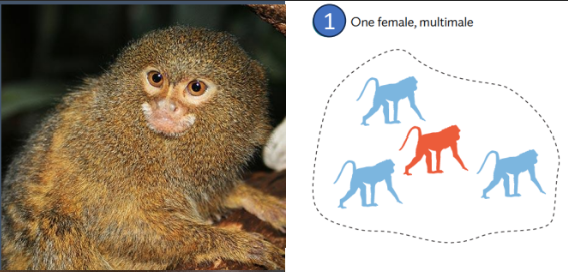
One male, one-female
Often called “pair bonding”
Mated pair and their young
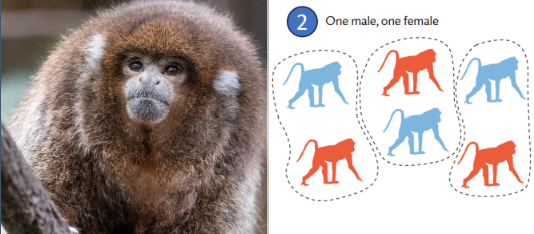
Solitary
“dispersed polygyny”
Individuals who forage for food alone
Most nocturnal primates and orangutans
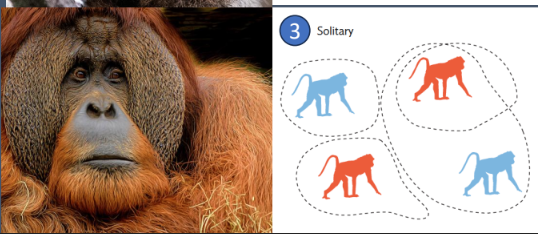
One-male-multifemale
“Polygynous” harems
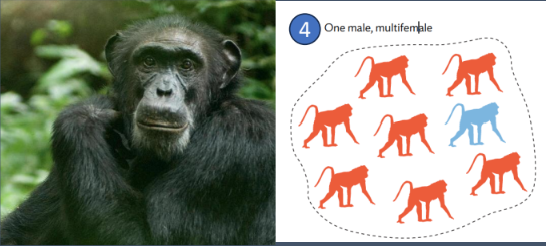
Multimale-multifemale
Largest of the primate groups
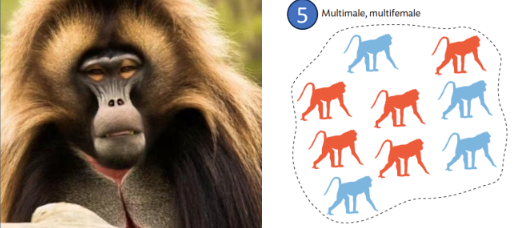
Why Be Social?
Predation
Feeding
Mating
Infant Care
Health
Predation
Benefits: Protection
Costs: Conspicous
Feeding
Benefits: Intergroup competition
Costs: Intragroup competition
Mating
Benefits: Excess, options
Costs: Competition, conflict
Infant Care
Benefits: Assistance, protection
Costs: Abuse, Infanticide
Health
Benefits: Grooming
Costs: Parasites
Dominance Hierarchies
Individuals within a group are ranked in relation to one another
Dominance Hierarchies Info
Establishes Order
Learned and Temporary status
Higher ranking individuals
Greater fitness
Temporary
Risks
Power, Attacks, Cortisol, Vigilante —> Die Younger
Autonomic Responses
Involuntary physiological response to external stimuli, Body reacts and Innate
Voluntary Responses
Gestures, facial expressions, and vocalizations, which are intended forms of communication
Displays (aka “ritual displays)
A combination of behaviors meant to communicate emotional state
Often associated w/ “aggressive” behavior
Mean to avoid the cost of physical violence
Show aggressiveness w/out violence
Affiliative Behavior
Behaviors that create social cohesion between individuals and groups
Touching, handholding, hugging, and grooming
Grooming (aka “allogrooming)
Grooming among individuals of the same species
Adaptive function: hygiene and social bonding
Reciprocal, Homeostasis, Stability
Main Ideas
• anthropologists study primates to establish hypotheses and models about hominin evolution
• behavioral ecology is the study of behaviors and interactions between individuals within a
population from an evolutionary perspective
• behaviors, like any phenotype, can increase an individual's fitness and be selected for or against.
• social structures are the result of natural selection in a certain habitat
• many factors influence the composition and size of social groups among primates
• changes to the environment or habitat will affect social organization
• researchers commonly observe five types of primate social groups
• social groups increase the relative fitness of its individual members.
• there are many costs and benefits of living socially, but the benefits often outweigh the costs
• primates exhibit different social behaviors that increase the reproductive success of individuals within social groups